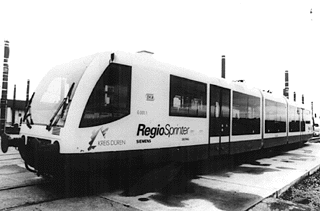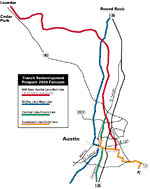https://www.austinchronicle.com/news/1997-02-28/527499/
A Light-Rail Named Desire
Capital Metro Plows Ahead With Studies on Cedar Park Line
By Mike Clark-Madison, February 28, 1997, News
 Capitol Metro took the public for a ride on the RegioSprinter last wekk to drum up support for light-rail |
Metaphorically, that put me where all of greater Austin now sits, as the Capital City's long-debated vision of rail transit finally leaves the station. Jim Robertson is Capital Metro's chief planner, the brains behind a decade's worth of work at the transit authority to bring fixed-guideway (that is, rail) transportation to our town, so he is this week's big winner. Paul Hernandez is the guiding force behind El Concilio, the coalition of Mexican-American neighborhood associations that has vigorously attacked light-rail, and Capital Metro in general, for most of the agency's 11 years of existence, and he is likely the week's top loser.
Yet as the dust settled and the TV reporters flooded the white, windowless box of a board-room with their lights and inane questions, and as Robertson was swamped with congratulations and Hernandez with condolences, both used the exact same line: "This is only the beginning."
Little Cap Met That Could
Well, it ain't exactly the beginning. As former Cap Met board member Lyndon
Henry reminded the crowd Monday night, he and others have been working on
light-rail studies and plans for Austin since the early 1970s, well before the
Capital Metropolitan Transportation Authority (CMTA) ran its first bus. Since
the agency's creation in 1985, developing a fixed-guideway system has been, at
least in theory, one of its priorities. And in 1992, Capital Metro came to the very same chasm it jumped on Monday night -- set to move ahead on a specific starter line, with a construction timetable and investment strategy in place. Back then, it faced the same array of vehement opposition it's faced the last few months, and CMTA got weak in the knees, deciding instead to go slow and do additional studies on the merits of rail in general. After which the whole issue got parked on "ignore" for about five years, or an entire generation in Austin time, until now.
Listening to discussion and debate, and to primarily negative coverage in the mainstream media, and to four hours of public testimony last week and nearly three hours at Monday's meeting, we wondered whether we should simply rerun our stories from 1992 and consider the issue covered. For Capital Metro has been barraged, not with just a similar set of concerns and criticisms, but the same concerns and criticisms, leveled by the same people in the same terms. Capital Metro has seen El Concilio railing about gentrification and insensitivity to the poor. It's seen the Crestview and Wooten neighborhoods, through which the proposed Red Line runs, decrying the train's impact on their property values, their mobility, their peace of mind.
 On top of these localized concerns, the Capital Metro board heard a deep and
wide strain of complaint about how the notoriously arrogant, inefficient and/or
inept transit authority -- which can't run its own buses on time, can't get its
schedules printed without a scandal, etc. et al. -- is hardly qualified
to manage and operate what would be, upon its full four-line buildout, the
largest single public-works project in Austin history, with a
billion-dollar-plus price tag that exceeds that of the new airport. And Capital
Metro board members have heard how their willingness to move forward without a
public vote -- which CMTA is neither required nor, under most circumstances,
empowered to hold -- is an unparalleled betrayal of the public trust.
On top of these localized concerns, the Capital Metro board heard a deep and
wide strain of complaint about how the notoriously arrogant, inefficient and/or
inept transit authority -- which can't run its own buses on time, can't get its
schedules printed without a scandal, etc. et al. -- is hardly qualified
to manage and operate what would be, upon its full four-line buildout, the
largest single public-works project in Austin history, with a
billion-dollar-plus price tag that exceeds that of the new airport. And Capital
Metro board members have heard how their willingness to move forward without a
public vote -- which CMTA is neither required nor, under most circumstances,
empowered to hold -- is an unparalleled betrayal of the public trust.
Rail: Panacea or
Urban Jewelry?
Judging from the alternately testy and conciliatory statements of Capital
Metro board members Monday night, they are way tired of hearing this stuff, and
their decision to commit -- for now, and with many qualifications -- to a
starter line was not particularly surprising. And while the dialogue has been
stuck in a tape loop since 1992, several facts have changed.First of all, we don't have Tony Kouneski to kick around any more. The former Capital Metro general manager, since decamped to New Jersey and beyond, earned low marks for his snake-oil tactics in selling light-rail as a panacea for all Austin's urban ills and, it must be said, lying about the then-proposed line's true character and cost. (By comparison, current Capital Metro general manager Justin Augustine III is a man of few, if any, words, who clearly doesn't want to become personally involved in the light-rail debate, and the members of the board are conversely more willing to put their necks on the tracks.)
Second, the Red Line, which runs entirely along the old Austin and Northwestern right-of-way, is different from the original 1992 starter line, which used the A&NW tracks only from Braker Lane to the Airport/Lamar junction (and through Crestview and Wooten), and then ran straight down Lamar, Guadalupe, and Congress Avenue. This latter leg has now become a later phase -- the Green, or Central, line in Capital Metro's four-line scheme. Several speakers at the last few public hearings have decried this change, feeling a central line would be much more immediately useful, but by putting it on the long-term track Capital Metro has quieted opposition from the central-city business and residential groups who, six years ago, joined Crestview/Wooten and El Concilio in whacking Cap Met upside the head. And avoiding the mighty costs of laying new tracks, Capital Metro hopes, will keep the cost of the Red Line low enough to fund with the authority's substantial cash on hand. This would allow the agency to avoid issuing revenue bonds, which would require a public vote, though the board tried on Monday to make clear its willingness to go to the voters in any event.
But the third change is, of course, the big one: We have a real traffic problem now. Back in 1992, it was easy to dismiss light-rail as a piece of urban jewelry, designed to glorify its boosters and builders whether or not it actually addressed the city's real transit needs. Now, even the most hard-bitten skeptics have a hard time denying that, even if light-rail is the wrong thing to do, we must do something lest Austin become a parking lot, and that any alternative is likely to be just as expensive and disruptive as the train. The ReBoom has brought a bunch more people into the debate, many of whom -- for example, the folks in Cedar Park and Leander -- are wildly in favor of light-rail. If Austinites, with or without any eventual public vote, deep-six light-rail now, it screws up not only Capital Metro's plans, but those of the Austin Transportation Study, which has presumed the eventual construction of light-rail a fait accompli.
On or Off Track?
As they voted on Monday to go ahead with engineering and environmental studies
for the Red Line, the Capital Metro board also worked mightily to convince
light-rail opponents, and the agency's detractors throughout Austin (that is,
most of our citizenry), that it was not merely listening to the choir, as it
were. The resolution that actually got adopted Monday night was different from
the one originally posted, and included much amended language to address, point
by point, all of the objections lately raised. While the whole board voiced its support for these changes, the instigator, or at least the spokesperson, for this effort appeared to be new appointee Susan Handy, the UT planning professor whose appointment was seen as a victory for progressives and transit advocates. The fact that Handy ended up suggesting that she may not vote to eventually fund light-rail, that it might not be the best solution for Austin, and that the crowd may be right and the authority wrong, illustrates how divisive light-rail has been to formerly stable Austin political coalitions. El Concilio, for instance, has drawn support for years from populists and progressives -- yet it's the left who support non-auto transit most vocally.
Conversely, while some business leaders -- such as the Downtown Austin Alliance -- voiced their unqualified support for light-rail, others -- such as the Chamber of Commerce -- presented a list of requirements for Capital Metro to meet, some quite elaborate, before they can support the plan. And even within the neighborhood world, there is conflict -- while Crestview representatives came to breathe fire, Wooten NA president Harold Blair conceded that the train's arrival in his neighborhood was likely inevitable, and proposed a contractual arrangement between Wooten and Cap Met to address local concerns, an idea that went over quite well with the board.
So maybe Robertson and Hernandez were right -- this is only the beginning of something. Over the next year, through an inevitably long and ass-numbing series of meetings and surveys and focus groups and impact studies, the rubber will finally meet the road, so to speak, for light-rail. Capital Metro has to prove that it can manage its way out of a paper bag, and the citizenry has to decide whether it will ever be willing to actually take concrete steps to address the problems about which it so loves to bitch. Along the way, we'll probably learn more about how Austin works than we may ever have known before, since unlike the Us vs. Them kabuki drama we're accustomed to, where light-rail is concerned, we are them and they are us. We'll keep you posted.
Copyright © 2024 Austin Chronicle Corporation. All rights reserved.
